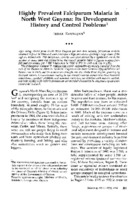Highly prevalent falciparum malaria in north west Guyana: its development history and control problems
| dc.contributor.author | Rambajan, Indal | es_ES |
| dc.date.accessioned | 2016 | |
| dc.date.available | 2016 | |
| dc.date.issued | 1994 | es_ES |
| dc.identifier.uri | https://iris.paho.org/handle/10665.2/26935 | |
| dc.description.abstract | After being absent from North West Guyana for over decades, falciparum malaria returned in force in 1986 and soon developed a high prevalence affecting a large share of the region's inhabitants. This falciparum upsurge was accompanied by a significant rise in the number of vivax cases that helped bring the annual parasite index to figures ranging from 260 positive smears per 1 000 inhabitants in 1986 to 973 in 1988 and 776 in 1991. The chloroquine-resistant P. falciparum strain responsible apparently travelled from the area of the Rupununi River in Southern Guyana to the more northern Cuyuni/Mazaruni/Potaro area in 1985, and from there was brought into the North West Region, probably by itinerant miners. Circumstances leading to the present endemic demonstrate how transient populations, resistant parasites, and economic restraints can interfere with malaria control, and how rapidly high malaria prevalences can establish themselves in receptive tropical areas vulnerable to attack | en_US |
| dc.relation.ispartofseries | Bulletin of the Pan American Health Organization (PAHO);28(3),sept. 1994 | en_US |
| dc.subject | Malaria | es_ES |
| dc.subject | Malaria, Falciparum | es_ES |
| dc.subject | Cross-Sectional Studies | es_ES |
| dc.subject | Guyana | es_ES |
| dc.subject | Plasmodium Falciparum | es_ES |
| dc.title | Highly prevalent falciparum malaria in north west Guyana: its development history and control problems | en_US |
| dc.type | Journal articles | en_US |
| dc.rights.holder | Pan American Health Organization | en_US |
Files in this item
This item appears in the following Collection(s)
-
Pan American Journal of Public Health
Revista Panamericana de Salud Pública




